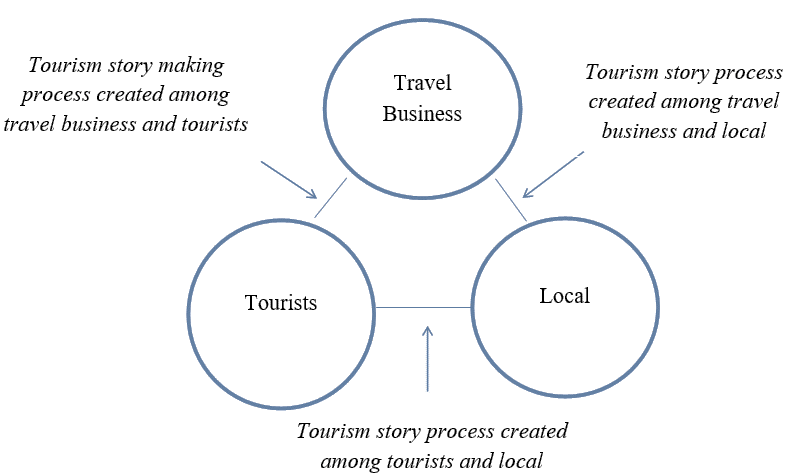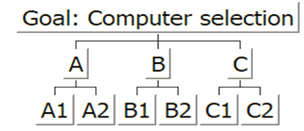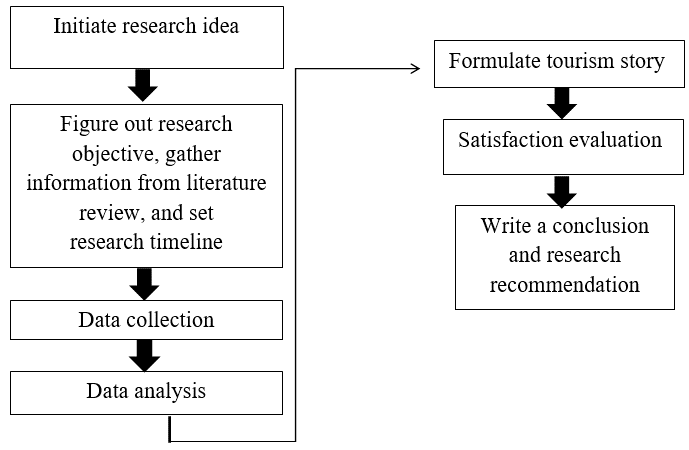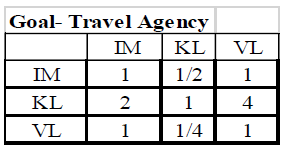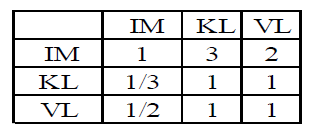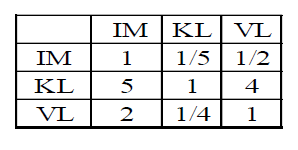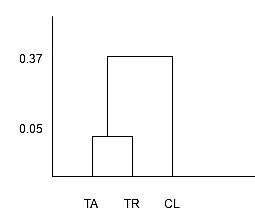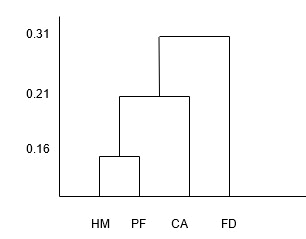Research Article: 2022 Vol: 25 Issue: 2S
Culture-Based Tourism Management Model in Creative Wat Makluea's Tie-Dye, Nakhon Pathom Province, Thailand
Supaksiri Prakancharoen, Suan Sunandha Rajabhat University
Keywords
Tourism Story Making, Analytic Hierarchy Process (AHP)
Abstract
Tourism story making is one of effective way that brings intangible tourism assets come to live and highlights value in local product and popularity. Research chose Wat Makluea, a community in Nakhon Pathom Province, Thailand, where tie-dye fashion has been made over past centuries. With intention to create new tourist destination there, this research is aimed to match demand and supply side between local and stakeholders: travel business, tourists, and government authorities; what are they expecting and what local will offer. Then, the research tickles three main variables in story making: history and Wat Makluea’s museum, local atmosphere, tie-dye pattern, and tie-dye production to formulate tourism story. Analytic Hierarchy Process (AHP) is used to find out the result. It shows that local and elder in community, travel business, and tourists agree with knowledge sharing condition. These groups also agree that history and Wat Makluea’s Museum is optional choice in story making process. However, tourist and travel business accept tie-dye production as optional alternative. Final tourism story starts presenting Wat Makluea history, process in tie-dye production and patterns therefore.
Introduction
Wat Makluea is the potential place to be new tourism destination in Thailand. Local wisdom especially masterful tie-dye production from ebony tree (which refers to “makluea” in Thai) will be key success in their tourism industry. However, there are few studies in tourism story to match demand and supply of what local wants to offer and what tourists and stakeholders expect by using tourism story as a tool to connect them.
Literature Review
Tourism Story Making
Tourism story making is a key success to boost tourism competitiveness whereas local tradition, history, and way of life have been told from generation to generation to conserve these heritages (Moscardo, 2019). Co-creation among local and stakeholders in story making is showed in Figure 1.
Panupat, et al., (2019) further argue that there must be community leader to give guideline and develop process in tourism story making. Final benefit of tourism story making is that tourists can get precise information about the place and have good perception toward community. All cultural and both creative tangible and intangible assets presented in tourism story contribute to higher income and better sustainability (Benjawan et al., 2019).
Analytic Hierarchy Process: AHP
Analytic Hierarchy Process or AHP is a method that helps making decision from many alternatives and conditions (Saaty, 2008). Conditions here can be, for example, a decision making in selecting and buying computer. Consumer will encounter condition such as performance (A), price (P), after sales support (C); performance (A) covers CPU size (A1), speed (A2), price (P) covers higher price (B1) and lower price (B2), after sales support (C) covers number of service points (C1) and waiting time for after sales service (C2). Purchase decision process is illustrated in Figure 2.
When considering condition, pairwise comparison is used. For instant, A against B, A against C, and B against C. To rank each condition, the score can be 1, 3, 5, 7 and 9. Buyer evaluates condition A with score 7, this score is higher than condition B. Therefore the score portion between A and B weights 1/7. Additionally, buyer evaluates condition A with score 3, this score is higher than condition C. Therefore the score portion between A and C weights 1/3. If buyer evaluates condition C with score 2 which is higher than condition B, we can illustrate the pair comparison matrix as following Table 1
| Table 1 Pair Comparison Matrix |
|||
|---|---|---|---|
| A | B | C | |
| A | 1 | 7 | 3 |
| B | 1/7 | 1 | 1/2 |
| C | 1/3 | 2 | 1 |
The score in comparison will be calculated to find out normalized weight. Even there are many conditions; they are run through the same process. In final decision, each alternative is compared to each other in higher condition. To further explain, condition A is applied to computer brands X, Y, Z. During the comparison process, consistency index and consistency ratio are analyzed. The consistency ratio must not be over 10%. In this research, Expert Choice program helps data analysis.
Cluster Analysis
Cluster analysis is method to group observation value regarding its similar attribute (Vandeginste, 1998). Cluster technique is varied e.g. K-means, Hierarchical clustering. Distance value can cluster observations. If the distance value is higher, attribute value shows that observation is not in the same group. To group many observation values, total distance value from all observations is measured. Total distance value is derived from Euclidean Distance method. Clustering method is showed Dendogram whereas its process runs through distance value (d) from two observations. Euclidean distance value will take sum square of different observation value in all attributes as showed in equation 1.

xi, k stands for attribute value of k at observation value i. Then, xj, k means attribute value from observation value j and k, the last attribute. After analyzing distance value of paired observations value (i and j), the result will be added to distance matrix. Example of observation value A, B, C, the distance value shows that that of A and B is 0.2, value of A and C is 0.8, and value of B and C is 0.6

From this, observation value of A and B is considered in the same cluster: distance value is 0.2. Additionally, regarding the distance value between A, B, and C, that of A, C is 0.8 while that of B, C is 0.6. These values are put in the final matrix. We can finally summarize that A and B are in the same cluster (value=0.2) while C is in different cluster with distance value 0.6
Methodology
Sampling Group
Researcher welcomed Wat Makluea local, community leader, government authorities, travel agency, and tourists to share background and community heritage. Data was collected to formulate tourism story that can precisely transfer what local and related parties reflect to visitors.
Research Variables
Key success components in tourism story making that leads to effective communication are: clear and correct information about local history and tradition, open discussion among relevant people to draw out storyboard, value creation, imagination, and knowledge exchange through activities, then visitor’s sense of belonging.
Research Framework
The study is conducted in 2020-2021 by following the framework below:
At starting point, researcher initiated the idea to do a study in tourism story making in Wat Makluea community where is situated researcher’s university. The community is great place to be a new tourist destination thanks to plentiful tourism resources as mentioned previously. Then, research objectives are constituted. Many theories in tourism story making are ground to place variables. Data collection was run through open discussion with group of interest in the community. Storyboard is formulated after receiving useful information from participants.
Data Collection
Data collection took place from October 2020 – August 2021. Meetings and discussions were organized throughout a year to get involved with local and relevant people in community. They are willing to create new tourist destination in their town and grant opportunity to share idea and suggestion to make tourism story. The total number in sampling group includes17 local, community leader, government authorities, and Buddhist monksin nearby temple. Then, 3 travel businesses and 5 tourists are also in sampling group.
Data Analysis
Researcher analyzed data given from sampling group during meetings and discussions. The story of Wat Makluea will be in both offline and online channel such as video, leaflets, social media, etc. Data analysis process applied Analytic Hierarchy Process and Cluster analysis to find out result. Consequently, final tourism story will be sent to sampling group again to check whether they are satisfied.
Results
Result From Studying Tourism Story Theories
After surveying the opinion of sampling group in tourism story making, 80% of them agree to apply condition of knowledge sharing and value creating while 20% of them agree with imagination encouraging condition.
For main topic in tourism story, 100% of sampling group chose tie-dye fabric to represent their community. 96% of them agree with historical and local museum including atmosphere. Finally, 92% of them agree with tie-dye printed fabric pattern.
The Index of Item Objective Congruence (IOC 10) of stated conditions and topics is showed below Table 2.
| Table 2 Index of Item Objective Congruence (IOC 10) |
||||||
|---|---|---|---|---|---|---|
| IOC 10 | ||||||
| Issue | Variable | Number of Agreement | Number of no comment | Number of disagreement | Percentage | Result |
| Condition | Knowledge:KI | 23 | 1 | 1 | 92% | Agree |
| Value:VL | 25 | 0 | 0 | 100% | Agree | |
| Imagination:IM | 22 | 1 | 2 | 88% | Agree | |
| Topic | (History & Museum:HM) | 24 | 1 | 0 | 96% | Agree |
| Community Atmopsphere :CA | 24 | 1 | 0 | 96% | Agree | |
| PrintedFabric: PF | 23 | 1 | 1 | 92% | Agree | |
| Fabric Dyeing:FD | 25 | 0 | 0 | 100% | Agree | |
Result From Sampling Group toward Condition and Topic in Tourism Story Making
Topics and conditions stated in IOC table, researcher did pair comparison. Set of data collection is given from three groups of sampling: Community Leader (CL), Travel Agency (TA), and Tourist (TR). Structure of conditions and topics in tourism which are rated by three groups of sampling is illustrated in Figure 4.
Three stakeholders in sampling group gave comment into two ways; goals and sub concepts of tourism story making. Two matrixes below show comment for all alternatives and all conditions. Other one shows comparison in specific alternative and condition. Therefore, sampling group’s data will be analyzed and performed through four tables (Table 3, 4, 5 & 6).
| Table 3 Pair Comparison |
|||||
|---|---|---|---|---|---|
| Sampling Group: | |||||
| TA TR/ CL | |||||
| Overal | Condition | IM | KL | VL | |
| (Goal) | Alternative | HM | CA | PF | FD |
| (Alternative) | |||||
| IM | HM | CA | PF | FD | |
| (Sub-concept) | KL | HM | CA | PF | FD |
| VL | HM | CA | PF | FD | |
Three comparison matrixes from three sampling groups toward each sub concept: Knowledge (KL), Value (VL), and Imagination (IM) are given in table set 4-6.
Goal- Travel Agency
| Table 4 Comparison Matrix of Travel Agency (Ta) Towards Each Sub Concept |
||||||||||||||
|---|---|---|---|---|---|---|---|---|---|---|---|---|---|---|
| TA-IM | TA-KL | TA-VL | ||||||||||||
| HM | CA | PF | FD | HM | CA | PF | FD | HM | CA | PF | FD | |||
| HM | 1 | 1/3 | 1/7 | 1/7 | HM | 1 | 1/5 | 1/3 | 1/6 | HM | 1 | 1/7 | 1/3 | 1/7 |
| CA | 3 | 1 | 3 | 1/5 | CA | 5 | 1 | 3 | 1/3 | CA | 7 | 1 | 5 | 3 |
| PF | 7 | 3 | 1 | 1/5 | PF | 3 | 5 | 1 | 1/5 | PF | 3 | 1/5 | 1 | 1/3 |
| FD | 7 | 5 | 5 | 1 | FD | 6 | 3 | 5 | 1 | FD | 7 | 1/3 | 3 | 1 |
Then, comparison matrix of Tourist (TR) towards each sub concept is given in table 5.
Goal-Tourist
| Table 5 Comparison Matrix of Tourist (Ta) Towards Each Sub Concept |
||||||||||||||
|---|---|---|---|---|---|---|---|---|---|---|---|---|---|---|
| TR-IM | TR-KL | TR-VL | ||||||||||||
| HM | CA | PF | FD | HM | CA | PF | FD | HM | CA | PF | FD | |||
| HM | 1 | 1/3 | 1/3 | 1/4 | HM | 1 | 1/7 | 1/3 | 1/5 | HM | 1 | 1/3 | 1/5 | 1/7 |
| CA | 3 | 2 | 2 | 1/3 | CA | 7 | 1 | 5 | 3 | CA | 3 | 1 | 1/3 | 1/5 |
| PF | 3 | 1/2 | 1 | 1/3 | PF | 3 | 1/5 | 1 | 1/3 | PF | 5 | 3 | 1 | 1/3 |
| FD | 4 | 3 | 3 | 1 | FD | 5 | 1/3 | 3 | 1 | FD | 7 | 5 | 3 | 1 |
Lastly, comparison matrix of Community Leader (CL) towards each sub concept is given in table 6.
Goal-Community Leader (CL)
| Table 6 Comparison Matrix of Community Leader (Cl) Towards Each Sub Concept |
||||||||||||||
|---|---|---|---|---|---|---|---|---|---|---|---|---|---|---|
| CL-IM | CL-KL | CL-VL | ||||||||||||
| HM | CA | PF | FD | HM | CA | PF | FD | HM | CA | PF | FD | |||
| HM | 1 | 2 | 2 | 6 | HM | 1 | 3 | 2 | 1 | HM | 1 | 2 | 3 | 7 |
| CA | 1/2 | 1 | 3 | 4 | CA | 1/3 | 1 | 1/3 | 1/2 | CA | 1/2 | 1 | 3 | 2 |
| PF | 1/2 | 1/3 | 1 | 2 | PF | 1/2 | 3 | 1 | 2 | PF | 1/3 | 1/3 | 1 | 2 |
| FD | 1/6 | 1/4 | 1/2 | 1 | FD | 1 | 2 | 1/2 | 1 | FD | 1/7 | 1/2 | 1/2 | 1 |
Analytic Hierarchy Process (AHP) Result
All results from table 4-6 are calculated to find out normalized weight and congruence ratio as showed in table 7-9.
Total Comparison
Table 7 shows an analysis to find out normalized weight of Travel Agency (TA), Tourist (TR), and Community Leader (CL). The outcome shows that Travel Agency ranks Knowledge Concept (KL) first (score 0.584). Consistency ratio is less than 10% therefore comparison index is compatible and data is reliable.
| Table 7 Analytic Hierarchy Process (AHP) Result |
|||
|---|---|---|---|
| TA | TR | CL | |
| KL | 0.58 | 0.55 | 0.683 |
| VL | 0.18 | 0.21 | 0.2 |
| IM | 0.23 | 0.24 | 0.117 |
| CI | 0.05 | 0.02 | 0.02 |
| CR | 8.62% | 2.22% | 3.44% |
Comparison in Topics and Alternatives
In table 8, normalized weight in History & Museum (HM), Community Atmosphere (CA), Printed Fabric (PF), and Fabric Dyeing (FD) scored by three sampling groups, the result shows that both Travel Agency (TA) and Tourist (TR) agree with Fabric-Dying (FD). They think the product can be selling point of community and added in tourism story (score 50.50 and 46.70). However, Community Leader (CL) chooses History & Museum (HM) as a key success in tourism story making (score 32050%). Consistency ratio is less than 10% therefore comparison index is compatible and data is reliable (Table 8).
| Table 8 Comparison In Topics and Alternatives |
|||
|---|---|---|---|
| TA | TR | CL | |
| HM | 0.055 | 0.071 | 0.325 |
| CA | 0.284 | 0.28 | 0.138 |
| PF | 0.155 | 0.182 | 0.279 |
| FD | 0.505 | 0.467 | 0.258 |
| CI | 0.05 | 0.02 | 0.02 |
| CR | 5.56 | 2.22% | 2.22% |
Cluster Analysis and Dendogram
When three groups of sampling give different score toward alternatives as showed in table 8, their score will be analyzed by Hierarchical Clustering method and consider their square root of sum square of different between attributes to group three groups in sampling who have same opinion.
Distance in observation value shows some alternatives are in the same cluster thanks to their less wide distance value. Others are in different cluster when considering wider distance value. Following Dendogram shows cluster of sampling group and alternatives (Table 9).
| Table 9 Weight in Alternatives and Conditions |
||||
|---|---|---|---|---|
| HM | CA | PF | CL | |
| TA | 0.055 | 0.284 | 0.155 | 0.505 |
| TR | 0.071 | 0.28 | 0.182 | 0.467 |
| CL | 0.325 | 0.138 | 0.279 | 0.258 |
Travel Agency (TA) and Tourist (TR) agree with same topic in story making while Community Leader agrees with different topic.
Figure 8 is Dendogram of observation value aroused from three groups of sampling.
Another analysis is considering topics and alternative cluster to put various topics in the same group; their new observation value is calculated again (Table 10).
| Table 10 Weight of Four Alternatives Clustered in Four Topics |
|||
|---|---|---|---|
| TA | TR | CL | |
| HM | 0.055 | 0.071 | 0.325 |
| CA | 0.284 | 0.28 | 0.138 |
| PF | 0.155 | 0.182 | 0.279 |
| FD | 0.505 | 0.467 | 0.258 |
Weight of four alternatives is analyzed to find out Euclidean Distance value. After this analysis, Dendogram is drawn as showed in image. There are three topics: History & Museum (HM), Printed Fabric (PF), Community Atmosphere (CA), and Fabric Dyeing (FD). Distance between groups is 0.21 and 0.31 respectively (Figure 9).
Tourism Story Making to Increase Value in Wat Makluea Community
From Table 8, we can see that both Travel Agency (TA) and Tourist (TR) agree with Fabric Dyeing (FD) while Community Leader (CL) focuses on History & Museum (HM). Figure 9 shows that both History & Museum (HM) and Printed Fabric (PF) must be presented in tourism story of Wat Makluea. Community Atmosphere (CA) and Fabric Dyeing (FD) must be separately presented in the story. In table 11, Analytic Hierarchy Process (AHP) Result in Travel Agency (TA), Tourist (TR), and Community Leader (CL) is showed.
| Table 11 Normalized Weight Summation |
||||||
|---|---|---|---|---|---|---|
| TA | TR | CL | Sum | Normalize | Percent | |
| HM | 0.06 | 0.07 | 0.33 | 0.45 | 0.15 | 15.03 |
| CA | 0.28 | 0.28 | 0.14 | 0.70 | 0.23 | 23.40 |
| PF | 0.16 | 0.18 | 0.28 | 0.62 | 0.21 | 20.53 |
| FD | 0.51 | 0.47 | 0.26 | 1.23 | 0.41 | 41.00 |
| sum | 1.00 | 1.00 | 1.00 | 3.00 | 1.00 | 99.97 |
From normalized weight summation in Table 11, we can summarize that structure in tourism story of Wat Makluea is categorized based on importance and relevance. Knowledge in Fabric Dyeing stands for the most important content in tourism story of Wat Makluea (41%). Then each topic is structured and put in the story with timing as showed in Table 12.
| Table 12 Topics Cluster |
||
|---|---|---|
| Section | Content | Important |
| 1 | FD | 41.00% |
| 2 | HM+PF | 15.03+20.53=35.56% |
| 3 | CA | 23.40% |
Final Storyboard for Wat Makluea Tourism Story
After all research processes, the storyboard illustrating the topic sequence and timing for Wat Makluea tourism is detailed in Table 13.
| Table 13 Wat Makluea Tourism Storyboard Including Sequence and Timing |
||
|---|---|---|
| Sequence | Location | Detail |
| 1 | Entrance and landscape of Wat Makluea community (timing 5 minutes) | - Narrator describes historical background of Wat Makluea and leads to canal that flows through the community, explain the detail of canal and reason why it plays role in local lifestyle. |
| 2 | Wat Makluea Temple and its components (timing 2 minutes) | - Narrator gets around the area and shows the place where ebony trees (used for tie-dye production) are planted. |
| 3 | Wat Makluea historical museum where ancient objects are housed (timing 10 minutes) | - Community Leader ( Mrs. Walee Suadmalai) leads to Wat Makluea historical museum and further explain community background including tradition, economy, and detail of ancient objects in the area. |
| 4 | Ebony tree (Makluea in Thai language), its advantage and utility to produce tie-dye (timing 10 minutes) | -Community leader and narrator explain the process of tie-dye production and how to create its printed fabric. Visitors can join the tie-dye production and get it as souvenir from community. |
| 5 | Thanks from community leader and narrator (timing 5 minutes) | - Community leader and narrator ends the story and welcome audience to visit Wat Makluea. |
Satisfaction Evaluation of Wat Makluea Tourism Story
Final tourism story for Wat Makluea is distributed to 25 research stakeholders. Researcher lets them evaluate the story by completing the evaluation form. After receiving feedback from respondents, the satisfaction score is showed in Table 14.
| Table 14 Satisfaction Evaluation Result |
||||||
|---|---|---|---|---|---|---|
| Evaluation | Local | Travel Agency | Tourist | |||
| Topic | Average | SD | Average | SD | Average | SD |
| Knowledge< | ||||||
| 1.1 History and Museum | 3.61 | 0.43 | 3.66 | 0.38 | 3.46 | 0.33 |
| 1.2 Atmosphere | 3.55 | 0.38 | 3.42 | 0.33 | 3.89 | 0.41 |
| 1.3 Printed Fabric | 3.88 | 0.41 | 3.94 | 0.45 | 3.54 | 0.37 |
| 1.4 Tie-Dye production | 3.71 | 0.36 | 3.87 | 0.41 | 3.94 | 0.32 |
| Value | ||||||
| 2.1 History and Museum | 3.49 | 0.33 | 3.55 | 0.37 | 3.74 | 0.42 |
| 2.2 Atmosphere | 3.65 | 0.41 | 3.84 | 0.39 | 3.83 | 0.3 |
| 2.3 Printed Fabric | 3.89 | 0.43 | 3.91 | 0.42 | 3.57 | 0.29 |
| 2.4 Tie-Dye production | 4.01 | 0.44 | 3.98 | 0.44 | 3.97 | 0.38 |
| Imagination | ||||||
| 3.1 History and Museum | 4.21 | 0.45 | 4.03 | 0.48 | 3.69 | 0.42 |
| 3.2 Atmosphere | 4.12 | 0.43 | 3.89 | 0.36 | 3.85 | 0.31 |
| 3.3 Printed Fabric | 3.68 | 0.42 | 3.77 | 0.38 | 3.97 | 0.33 |
| 3.4 Tie-Dye production | 3.77 | 0.39 | 3.49 | 0.41 | 4.03 | 0.39 |
Recommendations and Suggestions
When tourism story making of Wat Makluea is done, researcher found that there must be some aspects to develop. The sequence in story can be restructured for better story correlation. Those who are interested in tourism story research filed can take this point to develop their study.
Acknowledgement
Supaksiri Prakancharoen is lecturer at College of Hospitality Industry Management, Suan Sunandha Rajabhat University, Thailand. Her email address is supaksiri.pr@ssru.ac.th
References
Benjawan, K., Thoongsuwan, A., & Pavapanunkul, S. (2018). Innovation management model of world heritage city museum on historical park for creative tourism in the lower partof Northern Thailand. PSAKU International Journal of Interdisciplinary Research, 7(1), 110-120.
Crossref, GoogleScholar, Indexed at
Moscardo,G.(2019).Thestoryturnintourism.
Crossref, GoogleScholar, Indexed at
Panupat, C., Gulthawatvichai, T., & Karnjanakit, S. (2019). Development guideline for cultural tourism of Thai ethnic group: A case of Thai-Puan community.PSAKU International Journal of Interdisciplinary Research, 8(1), 234-242.
Crossref, GoogleScholar, Indexed at
Vandeginste, B.G.M., & Smeyers-Verbeke, J. (1998). Data handling in science and technology.
Thomas L., & Kirti, P. (2008). Group decision making: Drawing out and reconciling differences. Pittsburgh, Pennsylvania: RWS Publications.
Received: 08- Dec -2021, Manuscript No. jmids-21-8241; Editor assigned: 10- Dec -2021, PreQC No. jmids-21-8241 (PQ); Reviewed: 15-Dec-2021, QC No. jmids-21-8241; Revised: 20-Dec-2022, Manuscript No. jmids-21-8241 (R); Published: 04-Jan-2022
